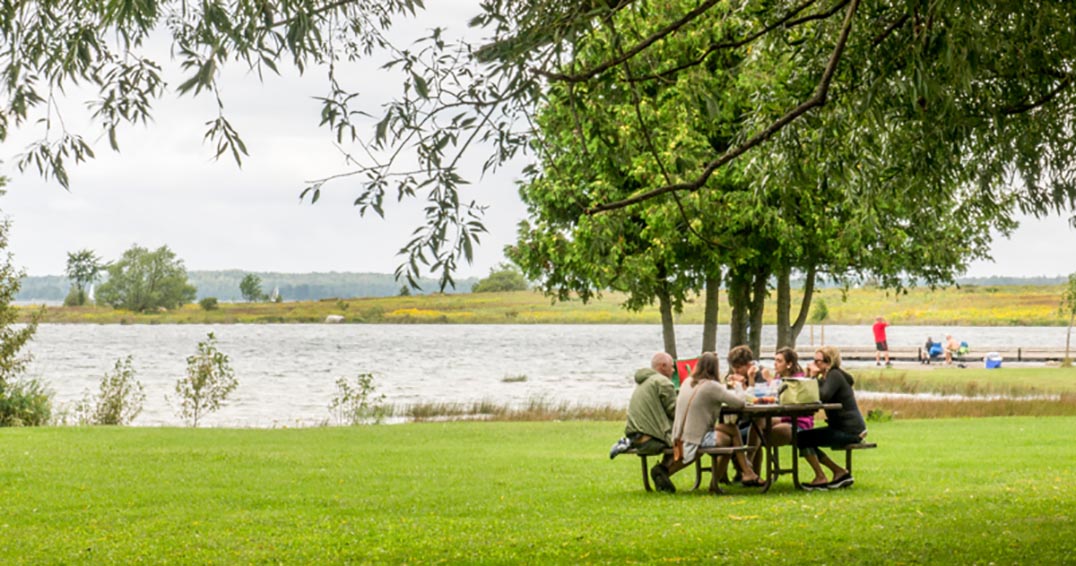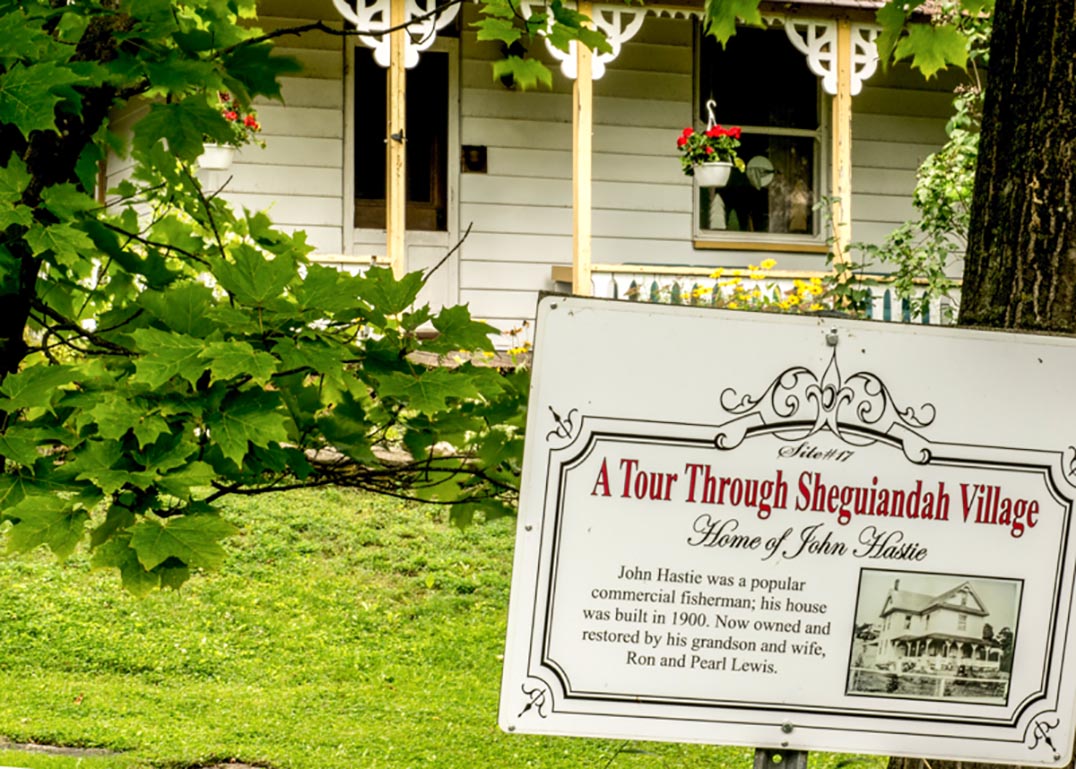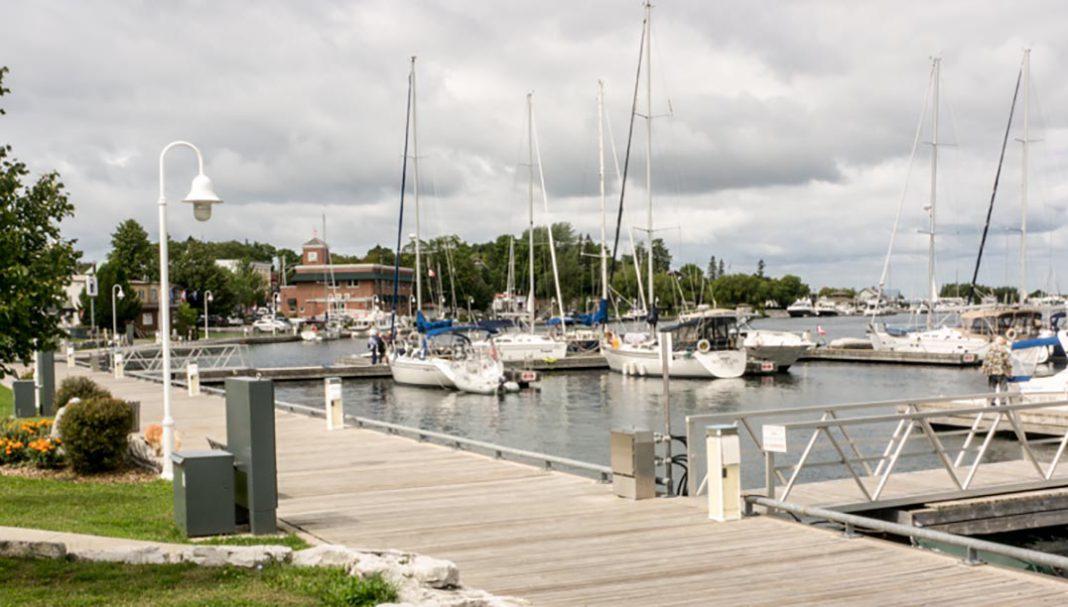by Isobel Harry
LITTLE CURRENT—Lumbering was the engine that powered settlement on Manitoulin Island after the 1862 Treaty opened the doors to newcomers, and Little Current ranked topmost in the milling and shipping of millions of feet of pine during the late 1800s until about 1920. Three large mills on the waterfront employed hundreds of men: at the Red Mill on Low Island, the Conlon Brothers Mill on Picnic Island and the Potter Mill where Boyle Marina is located, all near to each other and operating day and night, according to local historian Alexander (Sandy) McGillivray’s 816-page definitive work, ‘The Little Current Story.’
The original inhabitants of the Island’s largest town (pop. 1,500 today) were Indigenous, who came in the early 1850s, “entrepreneurs taking advantage of its harbour,” says Shelley J. Pearen in ‘Exploring Manitoulin’ (Third Edition). They named it “Wewebjiwang—where the waters flow back and forth”—and supplied wood to the passing steamers. “By 1853,” says Ms. Pearen, “Little Current consisted of George’s [Abbotossway] shanty, six birchbark wigwams and a clearing.” Later, in 1865, “13 Native families” were recorded at Little Current and “four non-Native families.” By 1870 most of the original residents “moved 7 miles west to the new Sucker Creek reserve [now Aundeck Omni Kaning First Nation].”

The first small lumber mill was constructed in 1874 and the Red Mill, the town’s first large mill, went up in 1886 on what is now Low Island, soon joined by the two other large mills that transformed Little Current into a major commercial centre on Lake Huron.
Trade in lumber and fish kept the port of Little Current bustling; one can only imagine the sights and sounds of the mill works running at full capacity, the smell of sawdust and of cooking in the boarding houses for hundreds of men, the steamships coming and going by the light of the Island’s first “bird-cage” lighthouse, built in 1866 where the cenotaph now stands—an exact replica is on the eastern portion of the boardwalk.
Remnants of the Red Mill remain on the west side of town, in Low Island Park, massive concrete pylons piercing through the wild vegetation, a physical link to the early days of settlement and an evocative reminder of the boomtown days that built Little Current.
Low Island Park is a peaceful, scenic spot with the North Channel lapping at its shores and a dock from which to launch a boat, or oneself, into the water, or to fish; the expansive view of Picnic Island just offshore and of the LaCloche Mountains beyond, the sailboats gliding on the bay invite a longer stay.

photo by Isobel Harry
The waterfront has been central to economic activity from then until now, and the far-reaching boardwalk affords the imagination a lot of room to roam—it extends from Low Island Park on the west to the Swing Bridge on the east, taking in the perimeter of the park, Spider Bay Marina and the marina of the Port of Little Current with their countless pleasure craft, passing snack stands and skirting along the northern edge of the Water Street business and shopping centre. Among the several storefronts stand Turners store, in business at this location since 1879 (the same year The Manitoulin Expositor began publication in Manitowaning—the newspaper relocated to Little Current in 1888), and the Anchor Inn Hotel, built as the Mansion House in 1888. These days, the walk might include a visiting cruise ship at dock, fit to contain the whole town’s population and then some, debarking vacationers onto the shore.
The Swing Bridge hoves into view, a unique sight beloved of all who reach it. Since 1913, it carried trains, and since 1945 trucks, trailers and automobiles across the Channel, and is the only land access point to the Island; trains no longer crossed the bridge after 1980. It continues to swing open for fifteen minutes each hour during navigation season; the queues of cars for crossing caused the Island’s only traffic light to be installed there.
Today, the Swing Bridge–the 114-year-old structure is an Ontario Heritage site—is in danger of needing replacement, according to the Ontario Ministry of Transportation, something barely grasped by its fans—how can you replace the indescribable sentiment that overtakes many upon reaching the bridge to the Island again, a visceral sensation akin to passing through the Looking Glass?
Highway 6 leads through Little Current’s ‘uptown’ shopping area with grocery stores, accommodations, pharmacy, hardware and home décor stores, a microbrewery and several restaurants lining the road. Soon, on the drive south, a sign marks the Strawberry Channel Lookout for unmatched views of Sheguiandah Bay and Strawberry Island. First known as Appissabikokaning, or “at the place where there is an abundance of violet-coloured stones,” the island stretches almost from Sheguiandah to Little Current. The exquisite 1881 Strawberry Island lighthouse is on the north side of the island, and can be seen best by boat or on land from the Swing Bridge and from Highway 6 across from Great LaCloche Island.
Just 10 kilometres from Little Current is the little village of Sheguiandah; both are situated within the municipality of the Town of Northeastern Manitoulin and the Islands (NEMI). Sheguiandah, a boomtown of grist and lumber mills, too, before the turn of the twentieth century, is now a pretty hamlet of historic homes and businesses on the babbling river that runs from Bass Lake to Sheguiandah Bay. Close to Little Current, yet far in feeling, it’s easy to nip over of an afternoon and take a walking tour by looking for signs posted in front of the many historical structures; read about the cheese factory, the milliner’s, the woolen mill and the family homes that flourished well over a century ago.
The Centennial Museum’s collection of archeological, geological and pioneer artifacts is complemented by several furnished log outbuildings situated in the verdant grounds; the ancient quartz quarry dating back 9,500 years ago after the glacial ice retreated is now due to open to the public in 2018.
Several churches are near here, notably St Andrew’s Anglican in Sheguiandah First Nation, built in 1886 on the site of an 1867 log church erected by the residents. Two village churches are on Townline Road: Sheguiandah United, formerly Methodist (1894) (with Sunday services in the summer) and St. Peter’s Anglican (1883); the Anglican services in St Andrew’s were in Anishinaabemowin while those in St Peter’s, while still in operation, were in English.
Two hiking trails, Lewis Twin Peaks and Orr Mountain, are short and offer grand views over Bass Lake, Sheguiandah Bay and the North Channel.
The grounds of the Museum and Batman’s Mill on the river are a cool respite, sweet settings for a picnic or a pause amidst the sweep of history in the Island’s earliest settlements.
The Centennial Museum of Sheguiandah is open daily in summer, 9 am to 4:30 pm; Thursdays 9 am to 8 pm. Telephone: 705-368-2367. The annual Heritage Alive Art Show and Sale is on until September 9; the annual Fall Fair is on September 16.
Information on the Municipality of the Town of Northeastern Manitoulin and the Islands (NEMI) is at www.townofnemi.on.ca
For the definitive books on Little Current, visit the Expositor Bookstore for ‘The Little Current Story’ by local historian Alexander (Sandy) McGillivray and ‘Reflections of Howland, Little Current and Vicinity’ by the Manitoulin Genealogy Club with the chapter ‘Early Years and Beyond’ by Sandy McGillivray. ‘The Bridge’ by Derek Russell is a detailed illustrated history of the Swing Bridge and ‘Exploring Manitoulin’ by Shelley J. Pearen is a guide to the Island with a historical bent.
For listings of accommodations, restaurants, shops and points of interest, pick up a free copy of This is Manitoulin; for events, read Manitoulin’s Magazine 2017, both available everywhere.




